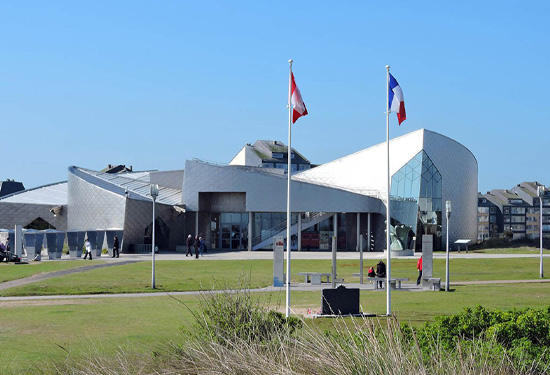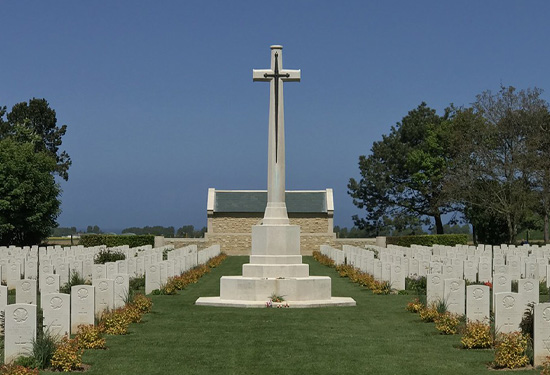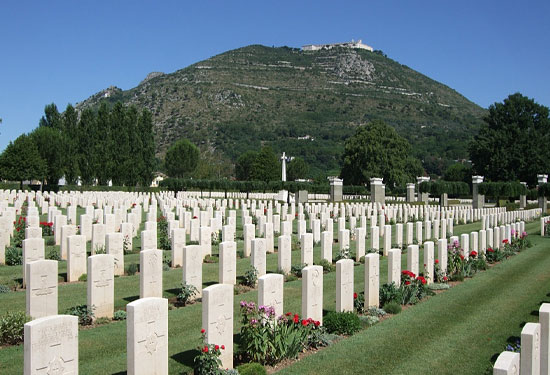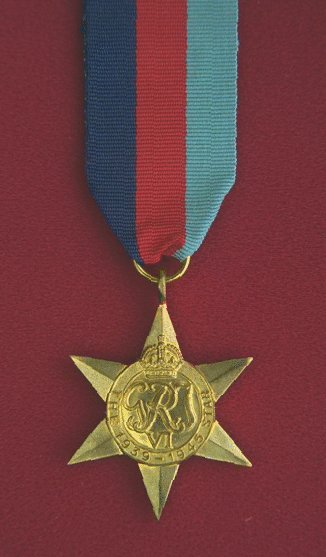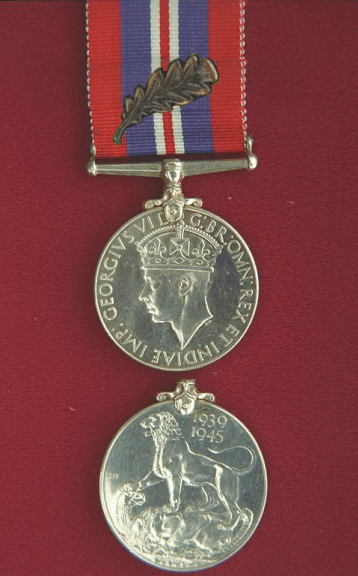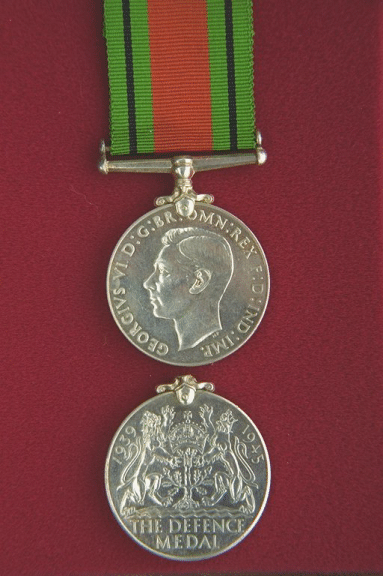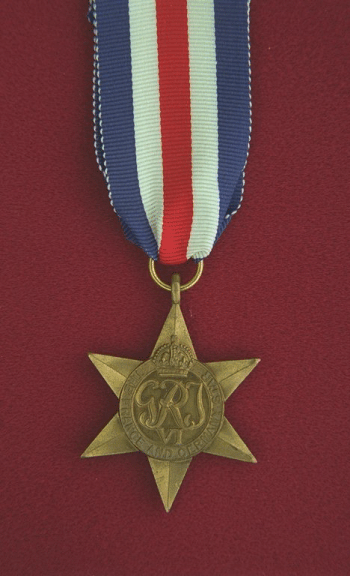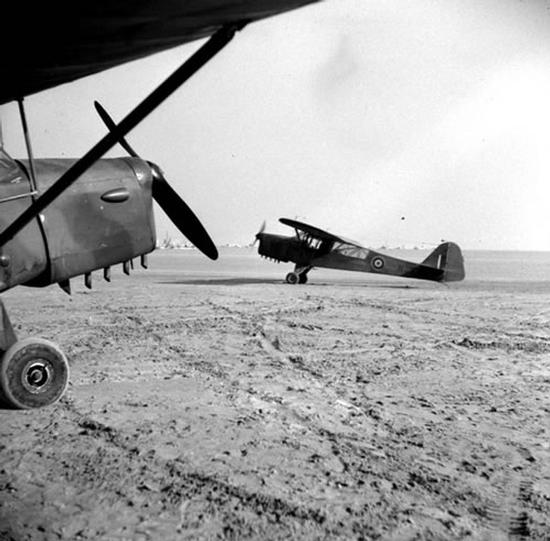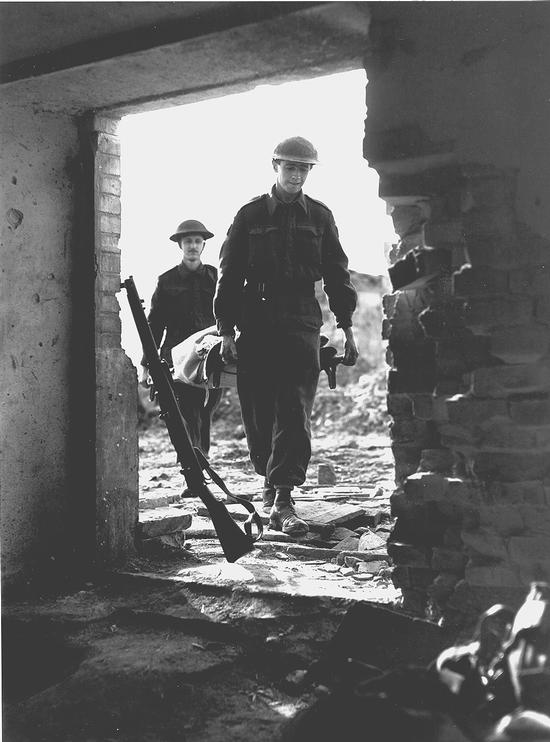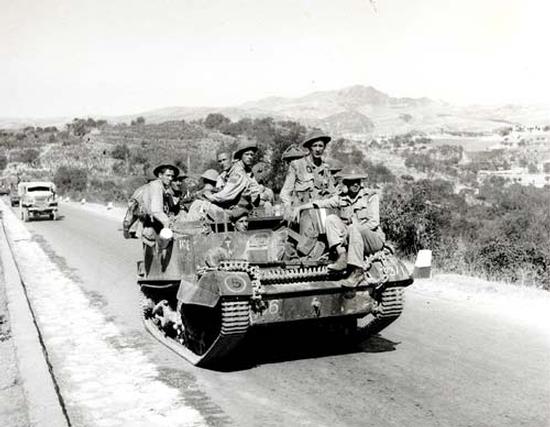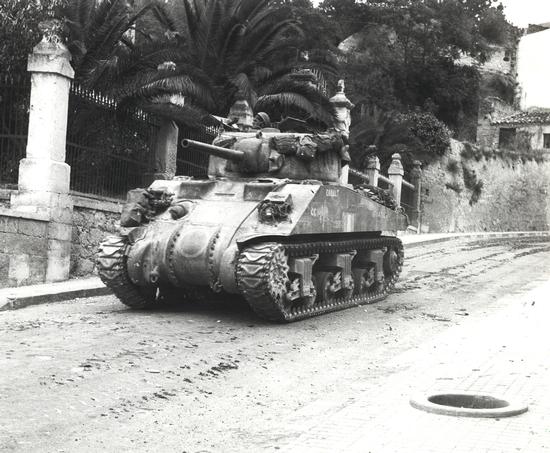
Italian Campaign
Canadian soldiers fought their way north in Italy from the summer of 1943 to early 1945.
10 July 1943 – 2 May 1945
Second World War
Table of contents
Section 1
Section 2
- Pushing through the Sangro and Moro Rivers to Ortona
- Italian winter stops the march
- The Battle in the Liri Valley
- Giving chase through the Liri Valley
- The capture of Rome
- The Road to Rimini
- The push to Rimini begins
- Weather and Germans slow the advance
- Much deserved rest
- Canadians' last actions in the Italian Campaign
- Second World War battles
Classroom materials
Introduction
Canadian troops played a vital role in the 20-month Mediterranean campaign which led to the liberation of Italy during the Second World War. In fact, this campaign was the first large-scale land operation in which the Canadian Army stationed in Great Britain took part.
In this campaign, which was fought in Sicily from July 10 to August 6, 1943, and in mainland Italy from September 3, 1943, to February 25, 1945, the fighting was particularly bitter. The Germans, taking full advantage of mountain peaks and swiftly running rivers, made Allied advance very difficult and costly. There were 25,264 Canadian casualties in the fighting, including more than 5,900 who were killed.
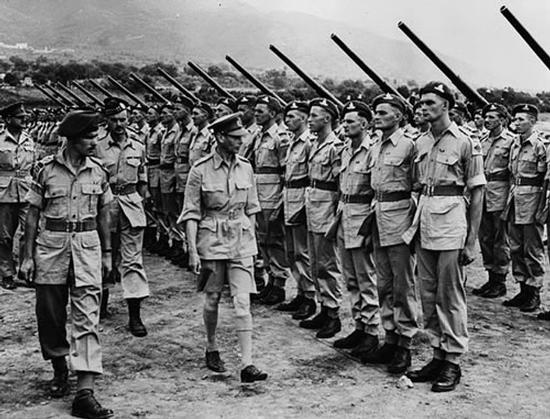
His Majesty King George VI inspecting the 2nd Medium Regiment, Royal Canadian Artillery (R.C.A.). Credit: Alexander M. Stirton /Department of National Defence / Library and Archives Canada / PA-128090
The conquest of Sicily
The assault on Sicily was to be the prelude to the invasion of mainland Europe. The invasion was assigned to the Seventh U.S. Army under Lieut.-General George S. Patton, and the Eighth British Army under General Sir Bernard L. Montgomery. The Canadians were to be part of the British Army.
The 1st Canadian Infantry Division and the 1st Canadian Army Tank Brigade, under the command of Major-General G.G. Simonds, sailed from Great Britain in late June 1943. En route, 58 Canadians were drowned when enemy submarines sank three ships of the assault convoy, and 500 vehicles and a number of guns were lost. Nevertheless, the Canadians arrived late in the night of July 9 to join the invasion armada of nearly 3,000 Allied ships and landing craft.
Landing near Pachino
Just after dawn on July 10, the assault (preceded by airborne landings) went in. Canadian troops went ashore near Pachino close to the southern tip of Sicily and formed the left flank of the five British landings that spread along more than 60 kilometres of shoreline. Three more beachheads were established by the Americans over another 60 kilometres of the Sicilian coast. In taking Sicily, the Allies aimed, as well, to trap the German and Italian armies and prevent their retreat across the Strait of Messina into Italy.
From the Pachino beaches, where resistance from Italian coastal troops was light, the Canadians pushed forward through choking dust, over tortuous mine-filled roads. At first all went well, but resistance stiffened as the Canadians were engaged increasingly by determined German troops who fought tough delaying actions from the vantage points of towering villages and almost impregnable hill positions. On July 15, just outside the village of Grammichele, Canadian troops came under fire from Germans of the Hermann Goering Division. The village was taken by the men and tanks of the 1st Infantry Brigade and Three Rivers Regiment.
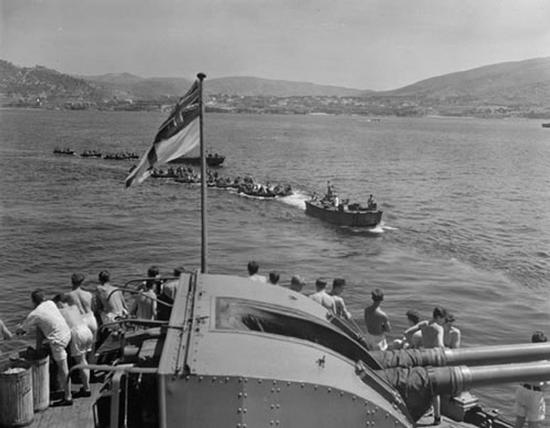
Assault landing craft alongside H.M.C.S. Prince Henry during preparations for Operation Dragoon. Credit: Gilbert A. Milne/ Department of National Defence / Library and Archives Canada / PA-107905
Pushing farther into Sicily
Piazza Armerina and Valguarnera fell on successive days, after which the Canadians were directed against the hill towns of Leonforte and Assoro. Despite the defensive advantages which mountainous terrain gave to the Germans, after bitter fighting both places fell to the Canadian assault. Even stiffer fighting was required as the Germans made a determined stand on the route to Agira. Three successive attacks were beaten back before a fresh brigade, with overwhelming artillery and air support, succeeded in dislodging the enemy. On July 28, after five days of hard fighting at heavy cost, Agira was taken.
Meanwhile, the Americans were clearing the western part of the island and the British were pressing up the east coast toward Catania. These operations pushed the Germans into a small area around the base of Mount Etna where Catenanuova and Regalbuto were captured by the Canadians.
Capturing Adrano
The final Canadian task was to break through the main enemy position and capture Adrano. Here, they continued to face not only enemy troops, but also the physical barriers of a rugged, almost trackless country. Mortars, guns, ammunition, and other supplies had to be transported by mule trains. Undaunted, the Canadians advanced steadily against the enemy positions, fighting literally from mountain rock to mountain rock.
With the approaches to Adrano cleared, the way was prepared for the closing of the Sicilian campaign. The Canadians did not take part in this final phase, however, as they were withdrawn into reserve on August 7. Eleven days later, British and American troops entered Messina. Sicily had been conquered in 38 days.

Personnel of Princess Patricia's Canadian Light Infantry advancing past a 'Sherman' tank. Credit: Jack H. Smith / Department of National Defence / Library and Archives Canada / PA-166755
Victory in Sicily
The Sicilian campaign was a success. Although many enemy troops had managed to retreat across the strait into Italy, the operation had secured a necessary air base from which to support the liberation of mainland Italy. It also freed the Mediterranean sea lanes and contributed to the downfall of Mussolini, thus allowing a war-wearied Italy to sue for peace.
The Canadians had acquitted themselves well in their first campaign. They had fought through 240 kilometres of mountainous country—farther than any other formation in the Eighth British Army. During their final two weeks, they had borne a large share of the fighting on the Allied front. Canadian casualties throughout the fighting totalled 562 killed, 1,664 wounded and 84 prisoners of war.
The invasion of the Italian mainland was to be the next great operation.
Canadians in Italy
One result of the Allied invasion of Sicily was the overthrow of the Italian dictator, Mussolini. However, although the new Italian government surrendered on September 3, 1943, the Germans immediately seized control and thus it was German troops that the Allies faced in their advance up the Italian peninsula.
The Eighth British Army (including the 1st Canadian Division, the 5th British Division and the 1st Canadian Army Tank Brigade) would lead the way across the Strait of Messina to the toe of Italy and then advance toward Naples. The Fifth U.S. Army (with two British and two U.S. divisions) would make a seaborne landing in the Gulf of Salerno, seize Naples and advance on Rome. The 1st British Airborne Division would land by sea in the Taranto region and seize the heel of the peninsula.

Canadian forces advancing from the Gustav Line to the Hitler Line. Credit: Strathy Smith / Department of National Defence / Library and Archives Canada / PA-140208
Across the strait and into mainland Italy
The assault across the Strait of Messina began on September 3, 1943. The Canadians, directed on Reggio Calabria, met little resistance since the Germans had withdrawn to establish a line of defence across the narrow, mountainous central part of the peninsula. The Canadians captured Reggio Calabria and advanced across the Aspromonte Mountains and along the Gulf of Taranto to Catanzaro. In spite of rain, poor mountain roads and German rearguard actions, they had moved 120 kilometres inland from Reggio by September 10.
Meanwhile, the Fifth U.S. Army met stiff German resistance as it assaulted the beaches of Salerno. To assist American troops in the breakout from the bridgehead, a Canadian brigade was diverted from the main Canadian line of advance to seize Potenza, an important road centre east of Salerno. Potenza was taken on September 20. The breakout was accomplished, and on October 1, the Fifth U.S. Army entered Naples. In the meantime, the 1st Canadian Infantry Brigade proceeded eastward, joined the British Airborne Division in the Taranto region, and then pushed boldly inland to the north and northwest. The 5th British Corps seized the Foggia airfield.
By the end of September, the German hold on northern and central Italy was still unshaken, but the Allies had overrun a vast and valuable tract of southern Italy. Allied armies stood on a line running across Italy from sea to sea. The next objective was Rome.

Nursing sisters of No.14 Canadian General Hospital, Royal Canadian Army Medical Corps (RCAMC), who survived the sinking of SS Santa Elena landing at Naples Credit: Department of National Defence / Library and Archives Canada / PA-116492
Pursuit from Reggio
As the Allies drove north from Naples and Foggia, the Canadians found themselves pushing into the central mountain range. Now the enemy resisted with full force. On October 1 at Motta, the Canadians fought their first battle with Germans in Italy, and a series of brief, but bloody actions followed. On October 14, the Canadians took Campobasso. The next day they took Vinchiaturo and the advance continued across the Biferno River. During the same period, one unit of the Canadian Army Tank Brigade played a distinguished role on the Adriatic coast by supporting a British assault at Termoli and its advance to the Sangro River.
In the 63 days since landing, the Eighth British Army had covered 725 kilometres. The "pursuit from Reggio" was over, however, as the Germans were prepared to make a stand from the coast south of Cassino on the Naples-Rome highway, to Ortona on the Adriatic shore. The German strength was now almost equal to that of the Allies and they had the advantage of being on the defensive. The liberation of Rome would not be easy.
Meanwhile, the decision had been made to strengthen the Canadian forces in the Mediterranean. On November 5, the Headquarters of the 1st Canadian Corps under Lieut.-General H.D.G. Crerar and the 5th Canadian Armoured Division arrived in Italy. General G.G. Simonds took over command of this division and was replaced in the 1st Division by Major-General C. Vokes. General McNaughton, who had objected to the division of the Canadian Army, retired soon afterward.

Private L.V. Hughes, 48th Highlanders of Canada, sniping German position 1944 / Foglio River, Italy (vicinity). Credit: Department of National Defence/Library and Archives Canada/PA-116842
Pushing through the Sangro and Moro Rivers to Ortona
As the first snow of winter began to fall, the Eighth British Army struck hard at the German line along the Sangro River on the Adriatic Coast. The aim was to break the stalemate that had developed and relieve the pressure on the Fifth U.S. Army in the drive to take Rome. The task was not easy as the Adriatic shoreline was cut by a series of deep river valleys. The British and Canadians succeeded in driving the Germans from the Sangro but were faced with the same task a few kilometres further north. Here, along the line of the Moro River, some of the most bitter fighting of the war took place. The Germans counter-attacked repeatedly and often the fighting was hand-to-hand as the Canadians edged forward to Ortona on the coast.
The mediaeval town of Ortona, with its castle and stone buildings, was situated on a ledge overlooking the Adriatic Sea. Its steep, rubble-filled streets limited the use of tanks and artillery and thus made this an infantryman's struggle. During several days of vicious street fighting, the Canadians smashed their way through walls and buildings—"mouseholing" as they called it. This was Christmas 1943. Meanwhile, a subsidiary attack had been launched to the northwest and the Germans, in danger of being cut off, withdrew from Ortona. The city officially fell on December 28.
Italian winter stops the march
Further offensives ground to a halt due to atrocious winter weather. During the lull, Simonds left for England and Major-General E.L.M. Burns succeeded him. In March, Burns took over the 1st Canadian corps from Lieut.-General Crerar, who returned to command the First Canadian Army in England. The 5th Canadian Armoured Division was taken over by Major-General B.M. Hoffmeister.
By now the Canadian Army in Italy had reached its peak theatre strength of nearly 76,000. Total casualties in the Corps had climbed to 9,934 in all ranks, of which 2,119 had been fatal.

Graves of personnel of the Edmonton Regiment killed in Battle of Ortona. Credit: Alexander M. Stirton/ Department of National Defence / Library and Archives Canada / PA-115151
The Battle in the Liri Valley
In the spring of 1944, the Germans still held the line of defence north of Ortona, as well as the mighty bastion of Monte Cassino which blocked the Liri corridor to the Italian capital. Determined to maintain their hold on Rome, the Germans constructed two formidable lines of fortifications, the Gustav Line, and 14.5 kilometres behind it, the Adolf Hitler Line.
During April and May of 1944, the Eighth British Army, including the 1st Canadian Corps, was secretly moved across Italy to join the Fifth U.S. Army in the struggle for Rome. Here under the dominating peak of Cassino, the Allied armies hurled themselves against the enemy position. Tanks of the 1st Canadian Armoured Brigade (formerly 1st Canadian Army Tank Brigade) supported the Allied attack. After four days of hard fighting, the German defences were broken from Cassino to the Tyrrhenian Sea and the Germans moved back their second line of defence. On May 18, Polish troops took the Cassino position and the battered monastery at the summit.

Ruins of the coliseum and castle, 21 May 1944/Cassino, Italy. Credit: Department of National Defence/Library and Archives Canada/PA-136204
Giving chase through the Liri Valley
On May 16, the 1st Canadian Corps received orders to advance on the Hitler Line ten kilometres farther up the valley. Early on May 23, the attack on the Hitler Line went in. Under heavy enemy mortar and machine-gun fire, the Canadians breached the defences and the tanks of the 5th Canadian Armoured Division poured through toward the next obstacle, the Melfa River. Desperate fighting took place in the forming of a bridgehead across the Melfa. Once the Canadians were over the river, however, the major fighting for the Liri valley was over.
The operation developed into a pursuit as the Germans moved back quickly to avoid being trapped in the valley by the American thrust farther west. The 5th Armoured Division carried the Canadian pursuit to Ceprano where the 1st Canadian Infantry Division took over the task. On May 31, the Canadians occupied Frosinone and their campaign in this area came to an end as they went into reserve.

Three men of the Canadian Infantry Brigade preparing to send a hand grenade into a sniper's hideout. 23 Oct. 1943/Campochiaro, Italy. Credit: Alexander M. Stirton/ Department of National Defence/Library and Archives Canada/PA-136198
The capture of Rome
Rome fell to the Americans on June 4. Less than 48 hours later, the long-awaited D-Day invasion of Northwest Europe began on the Normandy beaches. It remained essential, therefore, for the Allied forces in Italy to continue to pin down German troops.
The Canadians were now withdrawn for well-earned rest and re-organization, except for the 1st Canadian Armoured Brigade which accompanied the British in the Allied action as the Germans moved northward to their final line of defence.
The Road to Rimini
Autumn and winter 1944 saw the Canadians back on the Adriatic coast with the objective of breaking through the Gothic Line. This line, running roughly between Pisa and Pesaro, was the last major German defence line separating the Allies from the Po Valley and the great Lombardy Plain in northern Italy. Since many factories producing vital supplies were located in the north, the Germans would fight hard to prevent a breakthrough. The line was formidable, composed of machine-gun posts, anti-tank guns, mortar- and assault-gun positions and tank turrets set in concrete, as well as mines, wire obstacles and anti-tank ditches.
The Allied plan called for a surprise attack upon the east flank, followed by a swing toward Bologna. To deceive the Germans into believing the attack would come in the west, the 1st Canadian Division was concentrated near Florence, then secretly moved northward to the Adriatic.

Ruins of railway station, Rimini, Italy, September 1944. Credit: Department of National Defence/Library and Archives Canada/PA-41299
The push to Rimini begins
In the last week of August 1944, the entire Canadian Corps began its attack on the Gothic Line with the objective of capturing Rimini. On August 25, the Canadians crossed the Metauro River, the first of six rivers lying across the path of the advance. They moved on to the Foglia River to find that the Germans had concentrated their forces here. It required days of bitter fighting and softening of the line by Allied air forces to reach it.
On August 30, two Canadian brigades crossed the Foglia River and fought their way through the Gothic Line. On September 2, General Burns reported that; "the Gothic Line is completely broken in the Adriatic Sector and the 1st Canadian Corps is advancing to the River Conca." The announcement was premature for the enemy recovered quickly, reinforced the Adriatic defence by moving divisions from other lines and thus, slowed the advance to Rimini to bitter, step-by-step progress. Five kilometres south of the Conca, the forward troops came under fire from the German 1st Parachute Division, while heavy fighting was developing on the Coriano Ridge to the west. By hard fighting, the Canadians captured the ridge and it appeared that the Gothic Line was finally about to collapse. The Canadians battled for three more weeks, however, to take the hill position of San Fortunato which blocked the approach to the Po Valley.
Weather and Germans slow the advance
On September 21, the Allies entered a deserted Rimini. That same day, the 1st Division was relieved by the New Zealand Division, ready with the 5th Armoured Division to sweep across the Lombardy Plain to Bologna and the Po. But the rains came. Streams turned into raging torrents, mud replaced the powdery dust and the tanks bogged down in the swamp lands of the Romagna. The Germans still resisted.
September 1944 waned and with it the hopes of quickly advancing into the valley of the Po. On October 11, the 1st Canadian Infantry Division returned to the line and the 5th Division went into corps reserve. For three weeks, the Canadians fought in the water-logged Romagna. The formidable defences of the Savio River were breached, but the Germans counter-attacked to try to throw the Canadians back. Meanwhile, the Americans were progressing toward Bologna, and to halt their advance, the Germans took two crack divisions from the Adriatic front. The Canadians were thus able to move up to the banks of the Ronco, some ten kilometres farther on.

Truck and jeep of the 1st Canadian Division burning after being mortared by German troops. Credit: Terry F. Rowe / Department of National Defence / Library and Archives Canada / PA-170291
Much deserved rest
The Canadian Corps was now withdrawn into Army Reserve to recuperate from the ten weeks of continuous fighting and train for the battles which lay ahead. The 1st Canadian Armoured Brigade, meanwhile, continued to operate with the Americans and British in the area north of Florence. They would end their campaign in Italy in the snow-covered peaks in February 1945.
Changes in command occurred before the Corps returned to the line. On November 5, Lieut.-General Charles Foulkes succeeded Lieut.-General Burns as commander of the 1st Canadian Corps, and Major-General Vokes left for Holland to exchange appointments with Major-General H.W. Foster.
Canadians’ last actions in the Italian Campaign
The Canadians returned to battle on December 1 as the Eighth Army made one last attempt to break through into the Lombardy Plain. In a bloody month of river crossings which resulted in extremely heavy casualties, they fought through to the Senio River. Here the Germans, desperate in their resistance, drew reinforcements from their western flank and, aided by the weather and topography, stopped the Eighth Army. In January 1945 the Senio became stabilized as the winter line, and in appalling weather both sides employed minimum troops as they observed each other from concealed positions.
The Italian campaign continued into the spring of 1945, but the Canadians did not participate in the final victory. In February 1945 the 1st Canadian Corps began the move to Northwest Europe to be re-united with the First Canadian Army. There they would join in the drive into Germany and Holland and see the war in Europe to its conclusion.

- Date modified:













